The serve is the most complex stroke in the game of tennis. To master it, we need to break it down into smaller chunks.
But, in this complex process of analyzing each little segment of the service motion, we can lose sight of one of the essentials of a tennis stroke.
In my opinion, one of the most important moments in the stroke execution is the body (legs, arms, wrist, etc.) alignment at contact.
At contact, we actually transfer energy from the complex movements beforehand into the ball, and it is this moment and body alignment that determine how efficiently we do it.
Incorrect vs. Correct Body Alignment At Contact
An easy way to check how the player imagines the contact on a tennis serve is to simulate the serve into a back fence.
Slowly initiate your service motion from the beginning, and gently hit the fence and stop the racket there.
Now check 4 key body positions/alignments:
- forearm/wrist angle
- angle of your head
- position of the non-hitting arm
- angle of your body (where it’s facing/oriented)

In my experience, the most common mistakes in how tennis players imagine a contact point on the serve are:
- no angle between the forearm and the wrist (meaning the player likely doesn’t feel pronation)
- head position too vertical
- non-hitting arm swings to the side or back
- body is facing the fence (court or target when actually serving)
All these “mistakes” happen because players intuitively position themselves in a way that makes sense at first glance.
They want to reach as high as possible in order to have a better angle, and they want to keep their head and body turned towards the target area as that gives them a better orientation in space and a better aim.
But, it turns out that what is intuitive does not really work well on a tennis serve.
Observe now Roger Federer’s serve at contact and try to position in a similar way.
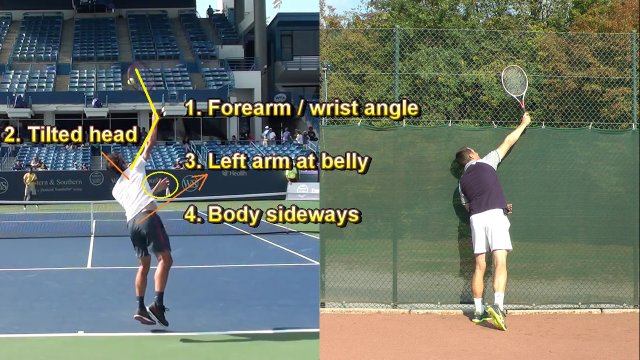
Roger Federer's serve at contact and 4 checkpoints
Then compare the power/force/strength that you feel at contact between the position where you’re facing the net and reaching as high as possible and the position Federer is in and that I demonstrate.
You will feel more power and stability in the second position.
4 Key Checkpoints Of A Tennis Serve At Contact
As I have explained in one of my previous articles, a tennis serve is a really difficult stroke to master.
Some parts of the service motion don’t really make sense until you are at such a proficiency level that you actually feel the benefit of that certain movement or position.
If you are seriously motivated to get to the bottom of an advanced tennis serve technique, then let’s dive deeper into each of these 4 checkpoints.
1. Forearm/wrist angle
It makes sense to try and reach as high as possible to get a better angle on the serve, but if you reach up too high, you will lose wrist stability/strength and the ability to pronate.
We use the word “pronation” to simplify terminology for a recreational tennis player, but what goes on as we are extending towards the ball and hitting through it is a complex combination of internal shoulder rotation, pronation and other movements.
Players who have no real angle between the wrist and the forearm at contact don’t really feel or use the pronation.
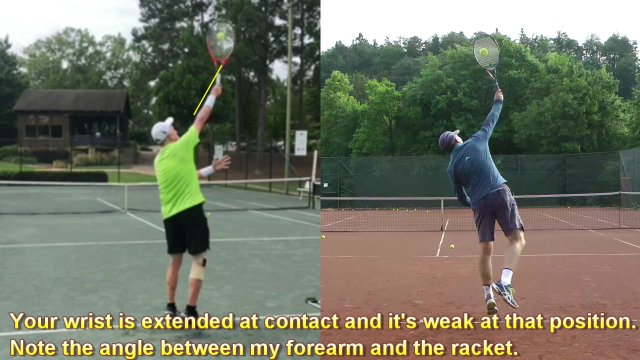
An example of a weak (unstable) wrist position at contact
So, in order to correct this part of a tennis serve, I recommend you engage in pronation drills rather than simply trying to correct this mechanically as you see in Federer’s example because it won’t really make sense to you.
It will make sense to you only when you feel the benefit of the forearm/wrist angle – and you will feel the benefit only after you practice pronation drills for a while.
2. Head angle
It is very natural to us to keep our head vertical/upright because that’s how we best orient in space and maintain balance.
The balance organ is inside our inner ear, and as soon as we tilt our head, that organ signals to us a possible loss of balance.
The second reason why players keep their head too upright is that they still want to orient towards the service box in some way, even during the serve.
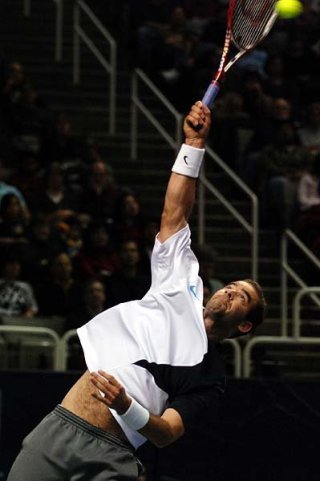
Note the head angle at contact from one of the best servers of all times - Pete Sampras
But, the problem with such an upright head position and serving a tennis ball above our head is that, when the head tilts back in order to look up, our neck quickly prevents further movement.
We can’t move our head back any more. As the player tries to do that, they cause a lot of tension in the neck, and that tension affects the whole shoulder region.
And with that stiffness in the neck and shoulder region, we definitely cannot serve with effortless power.
The head needs to tilt sideways just like the body and allow the player to look up from a more sideways position. This doesn’t cause any stiffness in the neck and shoulder region.
I sometimes have my players lie on the bench or the ground and ask them to hit a few gentle serves to exaggerate this point and get them used to such an unusual head position.

I have used this exercise quite a few times with my students with very good success. They "got" the idea very quickly.
Check my shoulder over shoulder article for more details.
3. Body orientation
Players mistakenly orient their body towards the target rather than the ball for the same reasons they make mistakes in their head orientation.
Another likely reason is that players believe they will get more power on the serve if they rotate/turn their body forward as they serve.
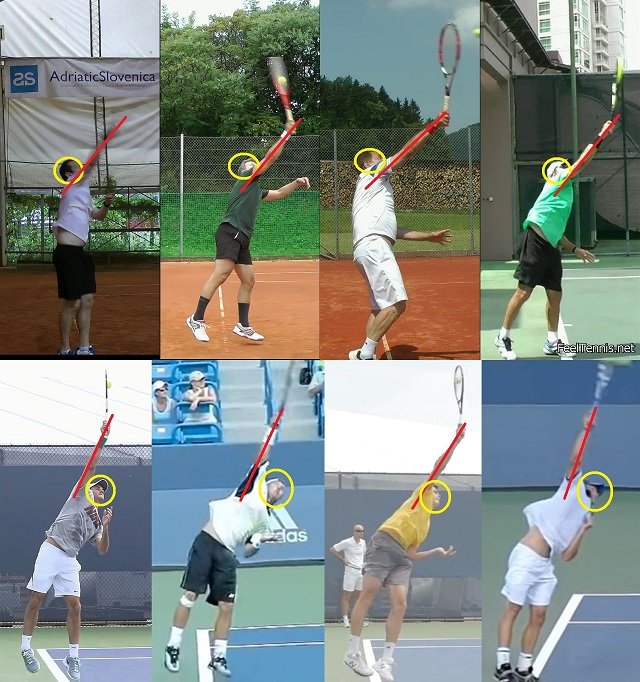
Note the head / arm relationship and body alignment difference
While forward rotation makes sense at first glance, the serve doesn’t really work that way.
The serve works more on the basis of a transfer of momentum.
That means that the body must initiate the movement, the arm lags behind and then, at a certain moment, the body decelerates and basically stops moving. That’s when the arm will take the momentum from the body.
Since the arm is much lighter than the body, it has to travel faster in order to maintain the same momentum.
This all sounds very complicated, but most people do this quite naturally when they throw something.
That’s why I recommend so many times to use throwing and swinging exercises so that you get in touch with that feeling of accelerating your arm through body deceleration.
You may not even be aware that you decelerate and stop your body for a split second – and, really, you don’t have to be aware.
You just need to be aware of the feeling and the ability of throwing or swinging really fast without must effort.
Coming back to the sideways body orientation at contact, it now makes more sense – at least in theory. The body is sideways because it has stopped moving for that brief moment so that the arm can accelerate.
A split second after contact, the body will continue moving as the arm pulls it forward and the player unwinds from the whole service motion.
Can you spot body deceleration just before contact in the video above?
My advice on how to make this happen is the same as always – don’t try to correct this mechanically, but use throwing and swinging exercises to feel what transfer of momentum actually means.
Once you get some sensation of effortless acceleration of the arm, then try to apply it to your serve.
(I also recommend you check the Why Is The Serve So Difficult article that explains more reasons why we don’t face forward at contact.)
4. Non-hitting arm position
The non-hitting arm swinging sideways or back instead of swinging towards the body (belly area) is simply the consequence of incorrect body and head alignments.
If you correct those first, you’ll be able to correct your non-hitting arm position quite easily.
In summary, the goal of this video article is to bring your attention to the correct body position at contact with the ball, as this is what determines how well you’ll transfer power from your body and speed of your racket into the ball.
Even if you execute all the service motion chunks before the contact correctly (stance, grip, backswing, coiling, trophy, drop, swinging up, etc.) your serve will not work well if you are not aligned correctly at contact.
Check your current serve position at contact on the back fence and see how it compares to the Roger Federer model that I also demonstrate.
If it’s not similar, then spend some time correcting it with the suggested drills as you think about it and visualize it before working on other parts of the service motion.

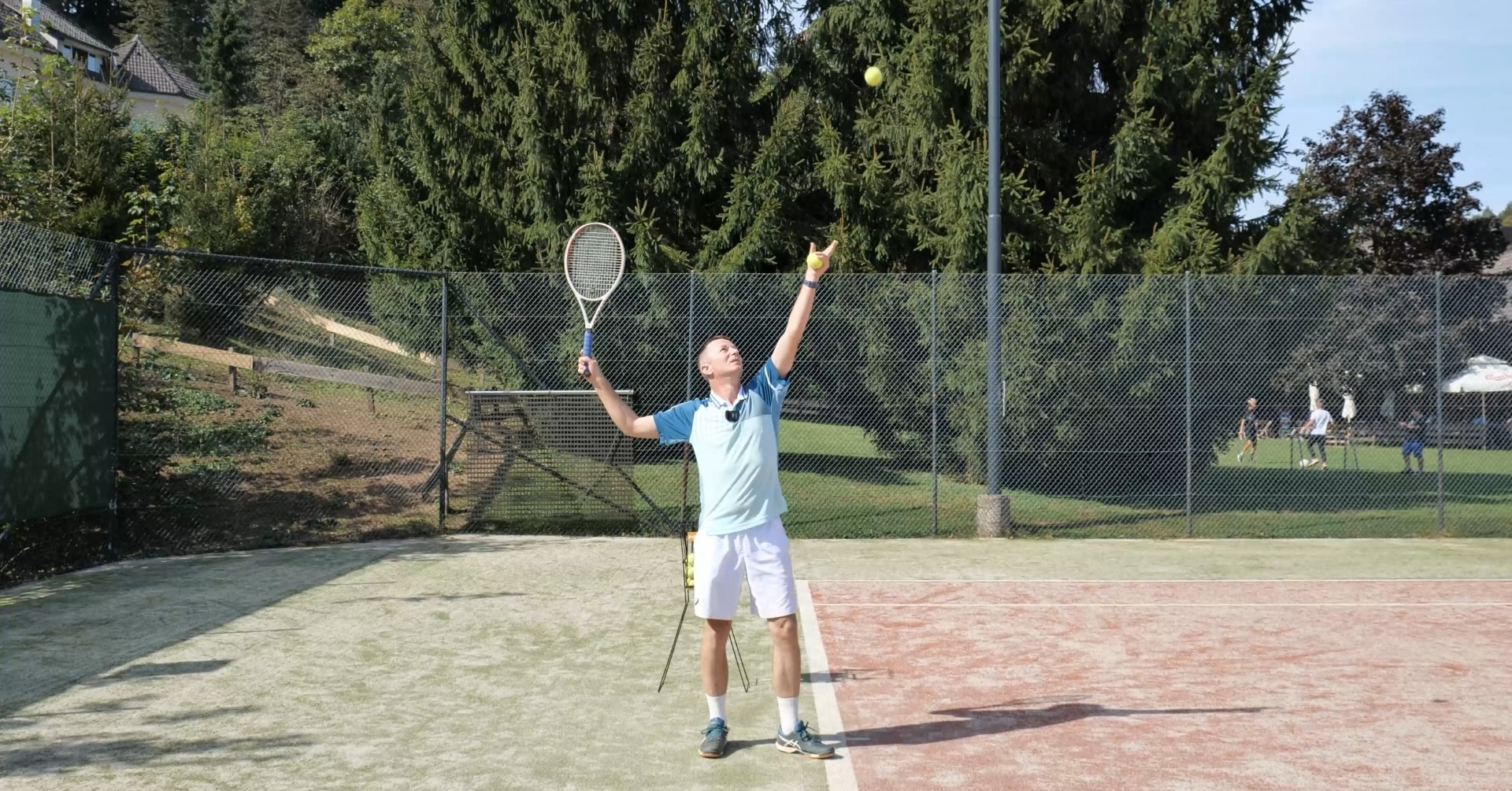


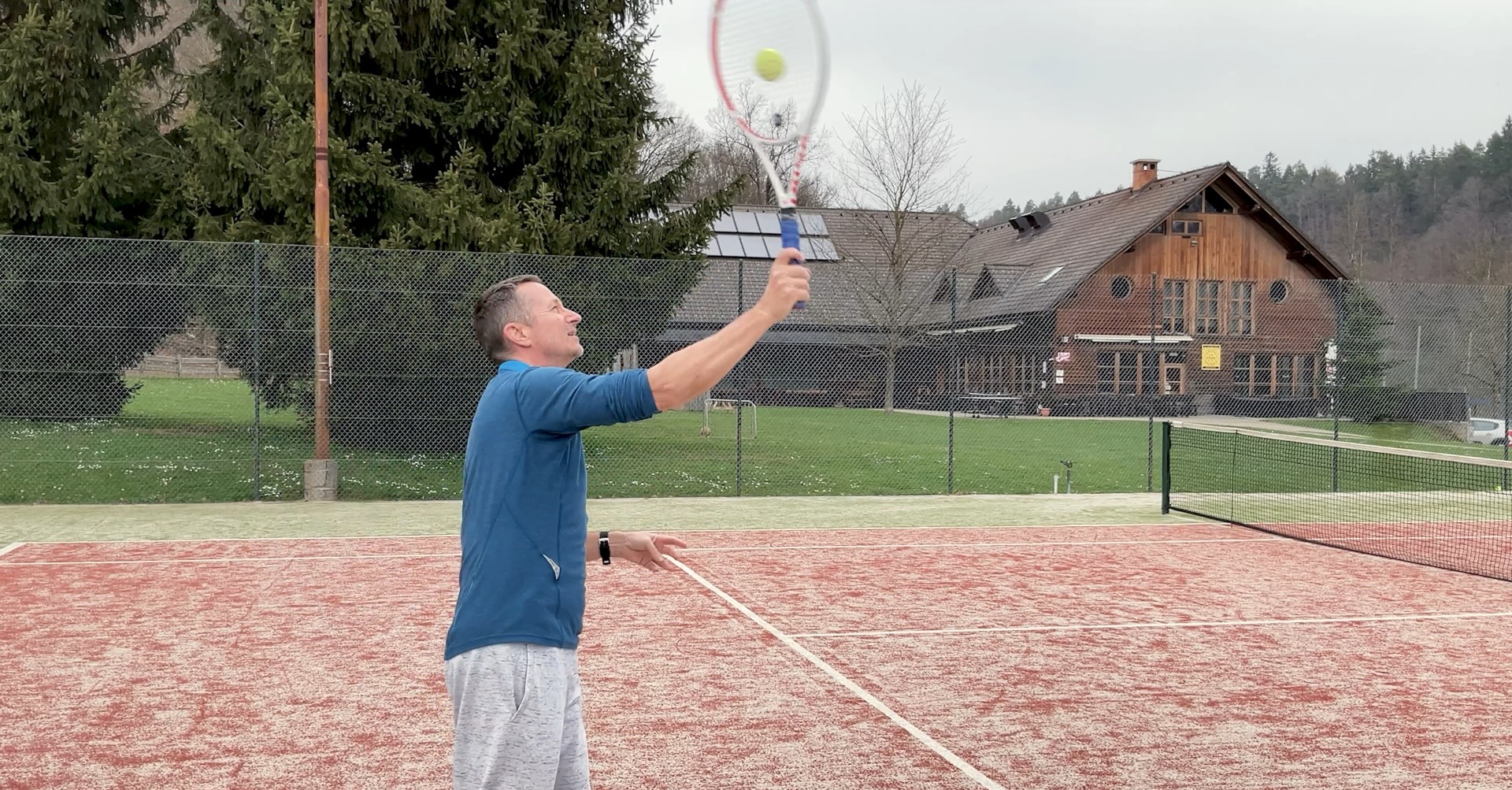
Tomaz, as always, your lessons are very practical and help at any level of player. The explanation of the mechanics of the serve is perfect.
The only thing that, I would humbly add, is the importance of the launching of the ball. Because it depends on almost all the rest of the movements that you explained, as well as the completion of the hit and the effect (kick, slice, flat) that you give to it.
Thanks for your tips and lessons.
A hug.
Marcelo from Argentina
Thanks for the feedback, Marcelo.
Yes, without an accurate toss the serve won’t work either as one has to chase the ball and lose balance and power in the process.
Here’s one article on the topic of the toss that may help:
https://www.feeltennis.net/serve-toss-drill/
Excellent analysis Tomaz. As usual highly enlightening. This is one of the biggest challenges for a club player. I have been in the process of evolving this for 3 years, integrating most of your tips and all I can advise is live with double faults during a match situation, try to get a half hour solo without game pressure, and don’t get discouraged.
Fantastic analysis of serve mechanics. Your simple explanation and practical approach to complex issues are the best. They work! I’m a senior level tennis player, and I’m still trying to improve my game. Thanks for all you do to promote the wonderful game of tennis. The Sport for A Lifetime!
Hello Tomaz,
your lesson about ideal tennis serve position at contact is very interesting and not easy for understanding all the details. For example, your explanation, that it has to be an angle between the forearm and the wrist at contact, is a big surprise for me. What is a point of that suggestion? How can we achieve that angle? Is it maybe a secret of how we grip the racket?
Have a nice day and thank you very much for your excellent lesson!
Emil
Hi Emil,
The angle between the wrist and the forearm is the consequence is pronation. The forearm twists because that helps us accelerate the racket head.
How to achieve that? Not by thinking or theory but by exercises that isolate pronation and help us feel it.
Only when you feel power from pronation you really understand it.
https://www.feeltennis.net/serve-pronation/
Some ideas also here:
https://www.feeltennis.net/why-serve-difficult/
Very helpful. I tried a few serve motions and could feel what you were saying. It puts the energy up into the arm, and then into the racquet, rather than all the energy going into turning the body, with the arm motion just along for the ride.
Thanks.
Super excellent instruction as always!
Hello Tomaz,
your video regarding contact point at serve is very interesting. Common tennis player has not the correct visualization about ball toss position and effective point of contact. Sometimes also during foreward the real body position is very far away from immagination. Thanks a lot beacause your video is an open door to improvement and correct undestanding of tennis. Best regards Armando.
hi TOMAZ …like always your video is absolutely clear and full of interesting things…
thanks a lot for all your jobs and thanks to you my tennis is going to a right direction…i can understand finally many many things…that were for me only questions…you are absolutely the number 1…
Awesome. I teach exactly like that, my style of serve is similar to Pete Sampras who took aces out of his pocket.
Hi Tomaz,
I have been following your lessons for the last couple of years and I keep getting Inspirations for improving my technique – what you say about focussing on the ball and not the Court and tilting sidewards and not backwards worked so well for me. I just want to thank you and let you know that I am very grateful that you continue to Share your insights.
Best,
Hartmut
Hi Tomaz
I’ve been working on my serve for a long time, with gradual improvement, but this has made a really big difference. It feels almost like the last piece of the jigsaw puzzle. It’s probably not, as there is always more to learn but I do feel that I finally have a complete picture of what is needed. Thank you so much for your detailed instruction
Jeremy
This is the best serve video I have seen and I have watched many. Using this advice my serve has already improved dramatically and for the first time more reliable and consistent. Thank you.
Hi Tomaz,
As always, your suggestions are the most useful! Thank you so much!
However, I was wondering if this applies to both first and second serves as ball position differ. For instance, looking at the contact point from the side/diagonally with tilted head – how would it work during second serve when ball is above your head (12 o’clock) as opposed to first serve when ball is slightly on your right ( 13 o’clock) ?
Many thanks again! I am learning a lot from your lessons!
Hi Boris,
I’ve attached two images from my Second Serve course where in one of the videos I compare a flat and a topspin serve. Hope the images answer your question.
Hi Tomas what is the ideal imagine at contact for the one handed backhand ?
This video along with your initial instruction on the serve is one of the clearest and easiest ways to develop a solid and reliable serve. The tip that brings together the idea of a pronating wrist creating the necessary wrist/hand angle producing the “snap feeling ” a good serve produces seems to be so important.
Tomaz — very well done.
Tomaz, excellent! I did it again -got 5 stars of 5 stars.
YES! “LIFT the ball, LIFT,LIFT.
My one addition: to prevent dropping the lifting hand/arm too soon, lift and hold and count 1 second, “one-thousand-one.” This prevents the head and shoulder from dropping before contact.
You are one the best, a really good ‘demo and do’ instructor.
‘Mox gut!’ or Very good!
Tim Garvey, Hilton Head Island/South Carolina, USA
Thanks for the wonderful feedback!
fine and very well done. However, can you speak to the wrist movement specifically: before, at contact and after contact.
Hi Pierre,
I personally do not feel any wrist movement during the contact. The wrist is very firm and I feel pronation and internal shoulder rotation giving the racket final acceleration.
Biomechanically there is some wrist movement but if we tell players to use the wrist they do it the wrong way.
I personally DO NOT teach to do anything with the wrist during contact.
Very nicely explained here by Ian:
https://www.youtube.com/watch?v=mcwiAv_a7TQ
In my view any wrist movements that happen around contact should be passive and not active, meaning the movement just happens because if inertia or transfer of momentum and not because we actually “do” it.
What is the exact movement of the wrist at contact in the serve? Still need to hold the racket (somewhat firmly). Difference between holding the racket and relaxed wrist!?__
Hi Pierre,
At contact the wrist becomes very firm and is in a neutral position, aligned with the forearm.
There is NO wrist movement at contact or a split second later. It holds firm especially when it comes to a flat serve.
Some players hold that firm wrist for a long time after contact, some relax it a bit earlier.
This video from Ian might also help you see that better:
https://www.youtube.com/watch?v=mcwiAv_a7TQ
Hello Tomaz,
I am a big fan of you from YouTube, your articles are always surprise me in a different option but it does explain perfect 🙂
My question is about orient at contact, roughly 45 degree to target makes perfect sense to me coz it is comfortable to forearm/wrist snap for pronation reason. But it’s going to be difficult to serve different target, especially at deuce court to serve out wide and Ad court serve down the T. It looks a physical issue I can hardly place that target if I don’t orient fully with an angle.
Thanks for your comments.
Jassay
Hi Jassay,
A tennis serve is the most complex and complicated stroke to master so at recreational level it’s highly unlikely a player will develop the serve technique to the level of the pro. I am not referring to power, just to technically correct serve.
So being oriented towards contact and serving to deuce (even wide) is something that every pro server does right. I am not saying it’s easy to get there but that’s how it is.
Check Federer’s serve in this video and pause at contact at around 8 seconds into the video. You’ll see Roger oriented to the right at 45 degrees and he is actually serving out wide with a slice.
https://www.youtube.com/watch?v=8xbC31AQqSg
One reason why you may struggle with this concept is also because you are not really holding a Continental grip and you’re not feeling or using the pronation well.
As soon the grip is not fully Continental then swing path of the arm wants to go more or less in the direction of the target.
In Federer’s case you can see that the arm’s swing path goes at around 90 degree angle in relation to the ball flight.
Working on pronation drills long term brings you closer to serving like a pro does…
Hi Tomaz,
Thanks a lot for your kind and prompt response!
Yes, the pronation needs more practices and it’s indeed hard to master(even little bit anti-human engineering in my option 🙂 ).
I meant the FLAT serve out wide at deuce court, my upper-body rotation will feel more locked and hardly keep 45 degree orientation if I insist it’s a out wide placement with the FLAT serve(I am a righty hand player), that is the thing confusing me a lot in my exercise…I believe my continental grip with forearm pronation(might be not well), so I am guessing is it likely tossing orient/path…
It’s easier to place down the T in the same way
Thanks
Regards
Jassay
Yes, flat or slice, it doesn’t matter, the player’s body position is always the same at contact. The racket angle difference between flat and slice is very small and there is almost no difference in body orientation.
Again, it’s not easy and perhaps you are oriented too much to the side.
Check this video where I hit all types of serves in all directions and pause the clip at contact when I hit a flat serve out wide (they are the first ones in the clip):
https://www.youtube.com/watch?v=8hGHl-5oRLs
Hi Jassay,
A tennis serve is the most complex and complicated stroke to master so at recreational level it’s highly unlikely a player will develop the serve technique to the level of the pro. I am not referring to power, just to technically correct serve.
So being oriented towards contact and serving to deuce (even wide) is something that every pro server does right. I am not saying it’s easy to get there but that’s how it is.
Check Federer’s serve in this video and pause at contact at around 8 seconds into the video. You’ll see Roger oriented to the right at 45 degrees and he is actually serving out wide with a slice.
https://www.youtube.com/watch?v=8xbC31AQqSg
One reason why you may struggle with this concept is also because you are not really holding a Continental grip and you’re not feeling or using the pronation well.
As soon the grip is not fully Continental then swing path of the arm wants to go more or less in the direction of the target.
In Federer’s case you can see that the arm’s swing path goes at around 90 degree angle in relation to the ball flight.
Working on pronation drills long term brings you closer to serving like a pro does…
Hi Tomaz,
Thanks a lot for your kind and prompt response!
Yes, the pronation needs more practices and it’s indeed hard to master(even little bit anti-human engineering in my option 🙂 ).
I meant the FLAT serve out wide at deuce court, my upper-body rotation will feel more locked and hardly keep 45 degree orientation if I insist it’s a out wide placement with the FLAT serve(I am a righty hand player), that is the thing confusing me a lot in my exercise…I believe my continental grip with forearm pronation(might be not well), so I am guessing is it likely tossing orient/path…
It’s easier to place down the T in the same way
Thanks
Regards
Jassay
Yes, flat or slice, it doesn’t matter, the player’s body position is always the same at contact. The racket angle difference between flat and slice is very small and there is almost no difference in body orientation.
Again, it’s not easy and perhaps you are oriented too much to the side.
Check this video where I hit all types of serves in all directions and pause the clip at contact when I hit a flat serve out wide (they are the first ones in the clip):
https://www.youtube.com/watch?v=8hGHl-5oRLs